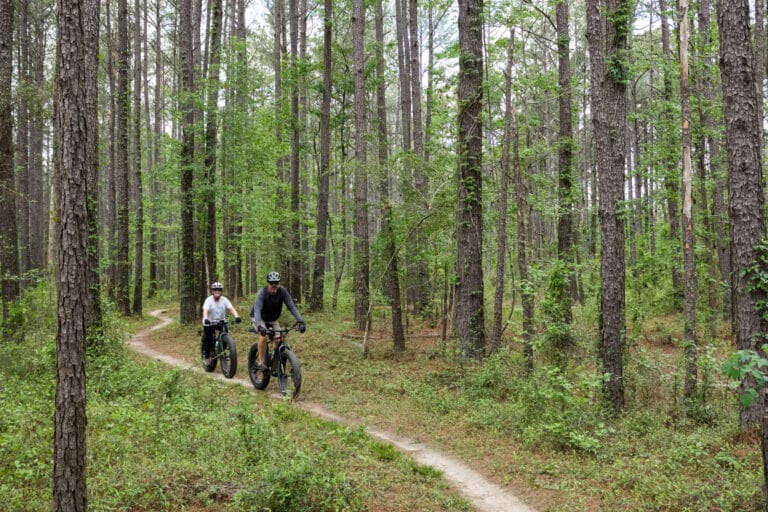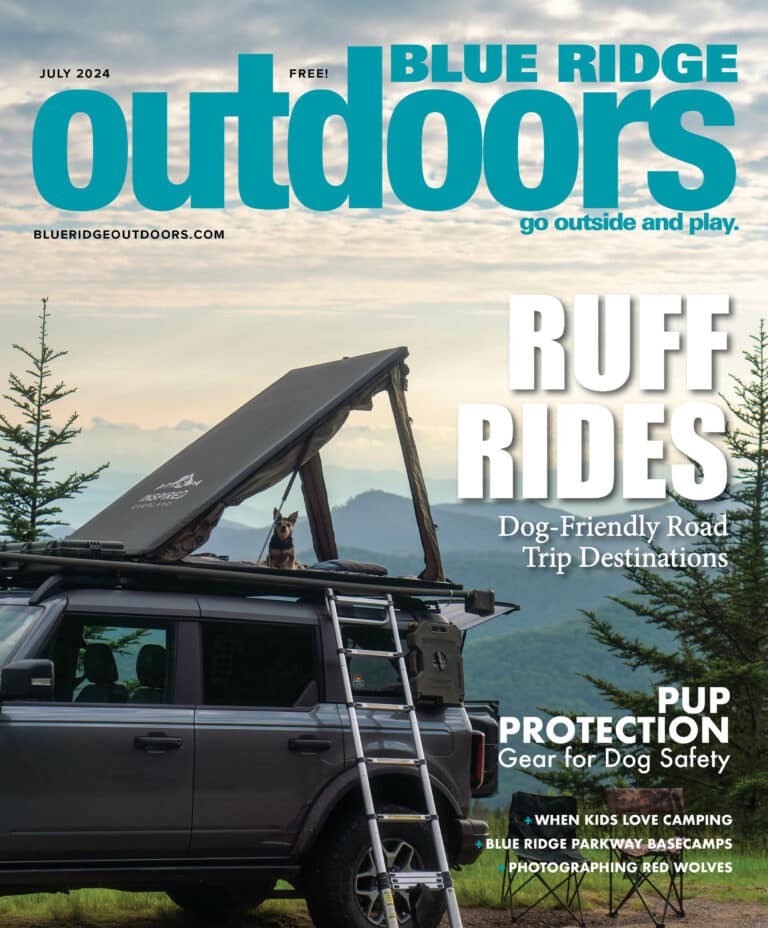Looking for a good excuse to ramp up the training this season? Check out 12 of the toughest, oddest, oldest, weirdest, and wildest events throughout the region.
Best First Mountain Bike Race
Big Bear Ultra
Big Bear Lake Trail Center, West Virginia
August 5, 2017
Situated near the Allegheny Highlands in the tri-state junction of West Virginia, Maryland, and Pennsylvania, the privately owned Big Bear Lake Trail Center is home to 50 miles of singletrack on its 5,000-acre property. The center exploded onto the mountain bike scene during the early 2000s when it served as a host for the 24-hour racing series, but its two-wheeled history dates back to the late ‘80s and the age of the Blackwater 100 motorcycle race.
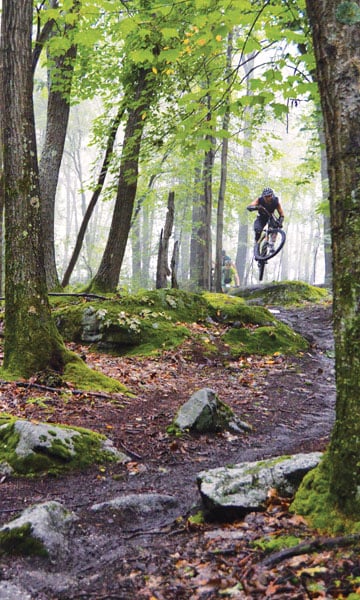
The 10th annual Big Bear Ultra pays homage to the center’s storied past, with 40-, 20-, and now 10-mile courses that incorporate some of the original trails with more recent singletrack additions. The trails here wind through fern-carpeted forests and pass over rock-studded tunnels choked with mountain laurel. It’s a magical place, a classic example of West Virginia mountain biking, and the event itself, says Big Bear Lake Trail Center’s Recreation Land Manager Jeff Simcoe, will appeal to riders of every ability.
“Even the fastest people are still very encouraging,” says Simcoe of the race-day environment. “We’ve seen people team up and stay together to grind this long-distance race out. There are certainly competitive riders, but it’s more about personal goals and finishing.”
Pennsylvania-based rider and writer Helena Kotala knows a thing or two about knocking out personal goals. Last year, Kotala signed up for the Big Bear Ultra Lite (20-mile course), unsure of what to expect—though an experienced rider, she’d never raced before and knew nobody in the West Virginia mountain biking scene. Despite rainy weather and muddy conditions, Kotala came out first in her class.
“I think I was most surprised at how fun it was,” Kotala says. “I was also pleasantly surprised at how nice and supportive everyone was. It was awesome to see such good sportsmanship and graciousness.”
To top it off, Simcoe and his crew do the post-race festivities right with a family-style cookout and party complete with local brews. With onsite camping available at the race start-finish line and plenty to do for the family, it’s more like a weekend getaway than a race.
Most Likely to DNF
Barkley Marathons
Frozen Head State Park, Tennessee
April 2017
For a non-refundable $1.16 you can enter the toughest footrace in the history of footraces. You probably won’t get in the first time you apply (if you can even figure out how to do so). You likely won’t get in the second or eighth time either, but consider this—in its 31-year history, only 14 people have ever finished the 100-mile part-endurance, part-orienteering race. With over 60,000 feet of elevation gain and a 60-hour time limit, do you really want to race Barkley anyway?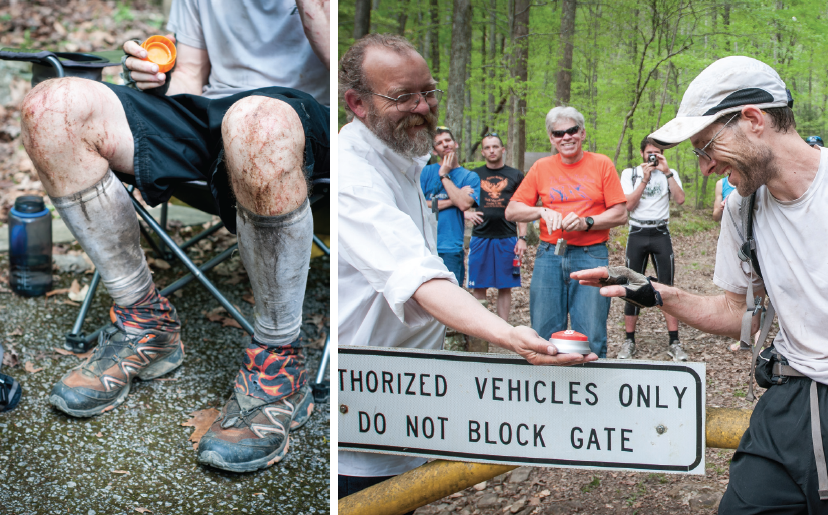 “If they do get entered, [the race director] Laz sends an email that says, ‘I’m sorry you’ve been accepted to the Barkley race which means you’re going to suffer unreal pain. It’s going to eat you and spit you out, it’s going to humble you, it’s going to get your goat, you’re going to cry like a baby,’ and all of those things are true,” says 2001 Barkley finisher and ultrarunning legend David Horton.
“If they do get entered, [the race director] Laz sends an email that says, ‘I’m sorry you’ve been accepted to the Barkley race which means you’re going to suffer unreal pain. It’s going to eat you and spit you out, it’s going to humble you, it’s going to get your goat, you’re going to cry like a baby,’ and all of those things are true,” says 2001 Barkley finisher and ultrarunning legend David Horton.
Horton, who is well respected in the ultrarunning community as director of his own line of ego-breaking ultra races, tried unsuccessfully for many years to complete the Barkley, which entails five 20-mile loops with 10,000 feet of elevation and a 12-hour time limit per loop. When he finally finished in 2001, he hadn’t just seen the edge of possibility—he’d jumped way the hell off it into the abyss without a parachute.
“It’s hell on earth,” Horton says. “Every time you finish a lap, it’s about choosing to go back ‘out there.’ ‘Out there’ is difficult. You can’t imagine how slow you can go. Barkley slow is the slowest slow there is. It just bugs me to death when Badwater says they’re the toughest race. It’s a walk in the woods compared to Barkley.”
Which is why you won’t see Horton toeing the line at Barkley any time soon. But for Greenville, S.C.,-based machinist Carl Laniak, Barkley is his everything. Laniak has started Barkley five times, but never finished. His first attempt resulted in a “fun run,” two loops shy of the whole enchilada, but three out of the five attempts ended in RTC, or refused to continue.
“You fail spectacularly,” Laniak says. “Dead reckoning will only get you so far when it’s in the middle of the night and there’s fog and you can only see 15 feet in front of you and of course you’re tired and a lot of the terrain looks similar.”
Laniak’s been lost for three hours before. He’s seen other participants come in with a broken kneecap, punctured calf muscle, dislocated shoulder, to which Laz offered a roll of duct tape and a shoulder shrug. Despite failing spectacularly for five years, Laniak has every intention of being back at it again later this spring.
“I would really like to not die without finishing the Barkley. There’s this part of me that wished I’d never gotten into it cause there’s always these other things I want to do, but I would love the luxury of finishing it,” he says, citing Barkley veteran Mike Dobies’ infamous quote, “Barkley is Laz’s sick joke and some of us like to take it seriously.”
Most Likely to [Temporarily]
Lose Vision
Hellgate 100K
Natural Bridge, Virginia
December 2017
With a distance of exactly 66.6 miles, you’d be right in assuming that this race is every bit as hellish as its name suggests. For 14 years, runners have lined up to start the Hellgate 100K at 12:01 a.m. Staying on course is not particularly challenging here—you need only follow the Glenwood Horse Trail from point A to point B. But the combination of a nighttime start, often brutal weather, and what Hellgate medical director Dr. George Wortley calls “Hellgate eyes” makes Hellgate no ordinary 100K.
“Usually I have anywhere from three to five cases of Hellgate eyes,” says Wortley of the annual event. “You can see a very slight cloudiness on the cornea,” but the runner, he says, can hardly see a thing. Just ask Bethany Patterson of Richmond, Va. Patterson won the Hellgate women’s division back in 2015, but she says her own experience with Hellgate eyes back in 2006 put her on the sidelines for a few years before returning to the race in 2014.
“If you stuck two cotton balls in the middle of your eye and tried to look through them, that’s what it was like,” Patterson says. “I literally could not see anything on the trail.”
“We have found people off the trail, wandering around, their vision is so poor,” Wortley says. “Another runner will have to lead them in like a seeing eye dog.”
That’s exactly what Patterson had to endure before DNFing. Fortunately, within a few hours, the cloudiness cleared up and she was able to see. But that whole not-being-able-to-see thing was unnerving. Unnatural. So what causes it?
According to Wortley, it has nothing to do with cold temperatures—“It happens in years when the temperature is nowhere near freezing,” he says. The cornea isn’t frozen; rather it dries up. Remember that 12:01 a.m. start? Nighttime trail running innately lends itself to intense focus, says Wortley. In fact, runners are so absorbed in maneuvering the technical leaf-strewn trail that they don’t blink nearly as often. Add the wind factor and you have the perfect recipe for Hellgate eyes.
“It’s been my impression that if someone has had vision corrective surgery, they are about twice as likely as the average person to get it,” Wortley adds. So how to avoid it? “Wear glasses or goggles and make a conscious effort to blink, blink blink.”
Most Likely to Dole Out a Slice of Humble Pie
Shenandoah Mountain 100
Stokesville, Virginia
September 3, 2017
What started out as a fun excuse to create a 100-mile, backwoods, mostly singletrack race with 13,000 feet of climbing in event director Chris Scott’s backyard has turned into something of a bucket list, test-your-mettle, mountain bike experience. While some participants filter through, try it once, and never come back, there’s a dedicated group of SM100 vets who come back year after year, despite the likelihood of getting shut down.
Just ask Sarah Temby from Ann Arbor, Mich. She’s been coming to the SM100 since 2010, when she volunteered while her then-boyfriend raced.
“Seeing everyone come through the aid stations excited, exhausted, happy, upset, the full range of emotions, well, the next year I decided to sign up and race it,” Temby says. “I had only been riding my bike for a year by then.”
Temby didn’t finish in 2011. Nor in 2012…or 2013. In 2014, she returned to volunteer instead and wrap her brain around what it was going to take preparation-wise to cross that finish line. She upped her training, competed in a few other 100-mile events, tackled more technical terrain. Then, in 2015, she came back ready to race. She finished in just under 13 hours.
“I think my heart exploded when I crossed the finish line,” she says. “ I had been waiting for that moment for years and it felt amazing.”
“People underestimate what it’s like to sit in the saddle for 12 hours,” says SM100 director Chris Scott. “It’s not just your legs pushing on the pedals. It’s your hands, your neck, your back, your butt, the balls of your feet on the pedals, all of your contact points. You get ridiculously sore when you’re in contact with the same thing for that long.”
Paul Buschi of Charlottesville, Va., knows this firsthand. He’s been racing the SM100 almost as long as the event has existed—11 starts in the race’s 19-year history. Initially, Buschi was in it to win it. He was always at the head of the pack and has podiumed and placed in the top 10 a number of times. But he’s also DNFed, too. Like in 2003 when he broke his frame around mile 50.
“The frame just collapsed in on itself and I flew into the woods,” Buschi remembers. “I had to figure out how to put the bike back together. Finally I realized it was pretty impossible. I walked the rest of the way to the aid station. If I was ever to win that race it might have been that day, too.”
Still, Buschi says, it’s all par for the course. Now, his focus at the SM100 is on having fun, eating pizza at the aid stations, and spending all day riding bikes in the woods with his friends.
Longest-Running Foot Race (1st place)
JFK 50 Mile
Boonsboro, Maryland
November 18, 2017
The JFK 50 Mile, which was first held the year after Kennedy’s asssassination, challenges runners to finish 50 miles in 13 hours or less. The race honors the challenge of another legendary president, Teddy Roosevelt, who urged U.S. Marine officers to be physically fit enough to complete 50 miles of running in under 20 hours. Little did he know that he would spawn generations of runners to push those limits even further.
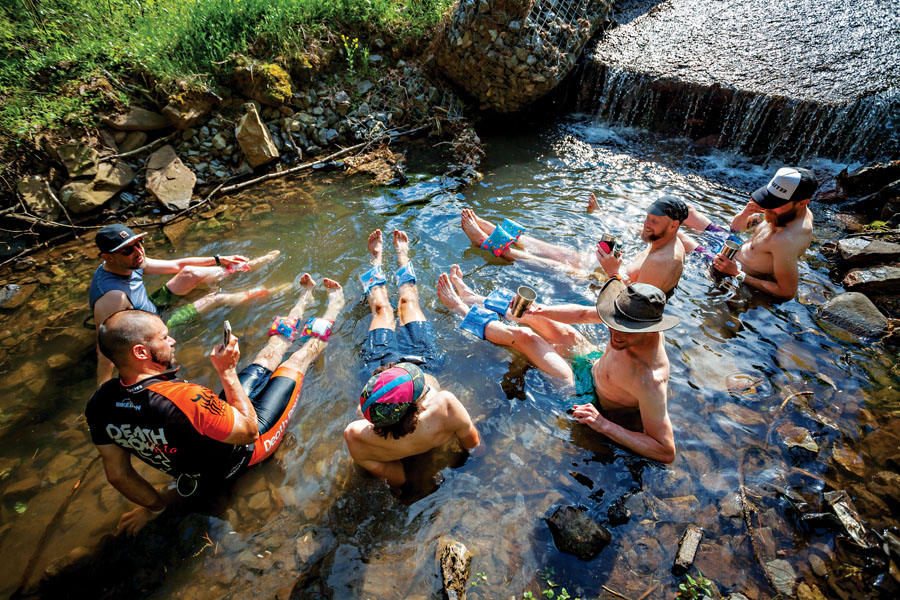
The JFK is now in its 55th year. “How many races survive a half a century?” says race director Mike Spinnler. “Most races disappear after a decade. Human beings only live so long—most races die with their race directors.”
But Buzz Sawyer, the original JFK 50 Mile race director, foresaw that very truth. That’s why he plucked Spinnler, a longtime race participant and winner (’82 and ’83) to take charge on the event’s 30th anniversary.
“No matter how you look at it, the marathon distance is a daunting task,” Spinnler says. “You double that, and throw into it the challenge of the 13-mile section of the Appalachian Trail, and you get this 50-mile race. It’s achievable, but still, for the average person, the thought of finishing a 50-mile foot race is almost unfathomable.”
That doesn’t deter the 1,200 runners who make the journey to Maryland to compete in this historic race. In fact, for local Kimball Byron, running the JFK 50 Mile is an annual tradition, one he’s upheld since 1968 when he was just 12 years old. Inspired by his father, who was one of the original JFK 50 Mile organizers, Byron has only missed the JFK 50 Mile once in 1985 when he was serving as a jet pilot in the Air Force. Last November, Byron finished his 48th JFK 50 Mile at age 61.
“It’s about struggling,” Byron says of the race. “No matter what you get in life, the good things come with the struggle, they come with the challenge.”
Of course, Byron’s come a long way since that very first JFK 50 Mile at age 12 when he fell asleep under a lamp post in a woman’s front yard just three miles from the end. The lady graciously offered Byron a ride to the finish. When he told her what he was doing, she gave him a kerosene lamp instead. Still, his commitment to the event is a testament to the unity and longstanding camaraderie the race has provided its participants all these years.
“I did it myself when I was 12,” says Spinnler. “It wasn’t unusual, but here he is a half a century later still doing it. It’s just remarkable.”
Longest-Running Foot Race (2nd place)
Peachtree Road Race
Atlanta, Georgia
July 4, 2017
In a close second for longest-running footrace, Atlanta’s Peachtree Road Race will be going into its 48th year, held annually on the Fourth of July. Race director Rich Kenah says the event has become more than just a footrace—it’s what people in Atlanta do for the Fourth.
“There are families who have participated in the Peachtree for decades and it’s just a part of their holiday routine,” Kenah says. “That’s something we’re very proud of.”
The 10K race attracts 60,000 runners every year to downtown Atlanta. In addition to the sweltering heat of Georgia-in-July, runners will have to contend with a pretty hilly course.
“I’d be lying if I said the course was flat,” says Kenah. “The first two to three miles really are almost all downhill, and then you start climbing. Cardiac Hill is certainly not the steepest, but it’s pretty long and that’s what people have to prepare for.”
Only finishers of the Peachtree will receive the race t-shirt, the design of which is not revealed until racers begin crossing the finish line. Organized by the Atlanta Track Club, the event also affords the non-profit a fundraising opportunity for its Kilometer Kids program, a free, running-based initiative aimed at getting kids in the community active.
Most Likely to Carn Out
Green River Games
Wilderness Cove Campground, North Carolina
May 20-21, 2017
Dabblers unite in this one-of-a-kind multisport adventure race. Now in its fifth year, the Green River Games is one of the stoutest, most technical multisport events in the country, linking together an eight-mile paddle down the Green River (including the notorious class V Narrows section), an eight-mile mountain bike course, and an eight-mile trail run over the Green River Game Lands’ rough and rugged terrain. If the all-day-suffer-fest doesn’t get you, the elements will.
“There are a lot of snakes,” says Green River Games director John Grace, “and more stinging insects than you can count. The trails are raw, steep, and rocky, just like the river. The place as a whole is harsh,” which is why even the most well-rounded adventuresport dabblers will incur some level of carn, be it a less-than-stellar line at Gorilla, or, as second-place women’s finisher Rebecca Cramer can attest, a broken collarbone.
“Every part of this race is technically challenging and it requires a different type of focus,” Cramer says. “Your focus on the river is different than your focus on a bike which is different than your focus when you’re running. In any other race, you might lose focus and it might not matter so much, but in this race, if you lose focus, you have the potential to crash.”
Back in 2015, just three miles into the mountain bike portion of the race, Cramer did just that. The drop was hardly noticeable, that is, until the front wheel of Cramer’s bike crunched down and bucked her over the handlebars.
“I think they call that an ‘endo,’” Cramer says, laughing now. “I landed on my back and the force of the land broke my collarbone. For a minute I thought I could keep going, and then I was like no dude. It’s over.”
Cramer hiked out the remaining five miles with another racer and healed up in time to compete in the 2016 Games, at which she placed second in the women’s class and sixth overall.
Most Like a Summer Camp for Adults
Trans-Sylvania Epic
Seven Mountains Scout Camp, Pennsylvania
May 25-29, 2017
Want a good reason to play hooky for a week and ride your bike in the woods? The Trans-Sylvania Epic in central Pennsylvania is your answer. Based just outside State College, Penn., this five-day stage race is unlike any other in that most of the stages start and finish right on site at Seven Mountains Scout Camp.
“It’s a really unique experience in the mountain bike stage racing realm,” says event director Mike Kuhn. “When you get to stay in one place every night, it lends itself to a very relaxed five days because you don’t have to move camp between stages. You don’t have to live out of a bag.”
Elite riders have come to the stage race from as far away as Australia, France, and South Africa, and the event also garners a lot of local riders, like Vicki Barclay, the U.S. National Singlespeed Champion in 2014. In 2015, she won the Trans-Sylvania Epic. Clearly, she’s not your average weekend warrior, but the atmosphere at the stage race, she says, is welcoming and supportive no matter the rider.
“The start line is always very fun and chatty,” Barclay says. “The thing I like about the Trans-Sylvania Epic is that it recognizes all racers. It’s very laidback, and I feel like they really cater to everyone. People who enter stage races are going to be competitive in some way, even if it’s with their friends or if not that than with themselves.”
The stages alone will be enough to test riders on their personal goals. Pennsylvania’s trails are well known to be extraordinarily rocky and technical. But if the experience is what you’re after, you’ll find a group of equally psyched racers ready to share in the adventure.
More-Than-Just-a-Climbing Event
The Rumble
Lake Lure, North Carolina
January 15, 2017
In the dead of winter, most climbers hang up their racks. Not in North Carolina. For the past three years, The Rumble has taken place at Rumbling Bald in Chimney Rock State Park to celebrate the state’s year-round climbing resources and raise funds for both Friends of Chimney Rock State Park and the Carolina Climbers Coalition (CCC).
Though the first two years of the event were largely centered around the bouldering competition, this year, the climbers turned to stewardship of the area they cherish so dearly. Last fall, Chimney Rock sustained wildfires that damaged over 3,000 acres of forest. Stewardship, says CCC Treasurer Will Goodson, was always a component of The Rumble, but with the recent wildfires, giving back to the land became the utmost priority.
“It’s gone from a climbing competition to an appreciation and recovery event that benefits the park,” Goodson says. “Rumbling Bald is a crown jewel of the Southeast. This is bigger than all of us.”
This year’s trail maintenance day brought out dozens of people to clean up debris and clear trails from downed trees. Goodson hopes that the event will set a strong precedent for the CCC’s future interactions with Chimney Rock State Park, which at one time was entirely closed off to climbers. Climbers are now one the park’s main user groups, and Goodson wants the Lake Lure community to see that climbers care about topics that transcend climbing, such as economic development and environmental restoration.
Most Likely to Hallucinate
Trans North Georgia Adventure
South Carolina border —Alabama border
August 19, 2017
Trans North Georgia Adventure (TNGA) founder David Muse would never think to consider himself the sole creator of this 350-mile long route. Maybe he doesn’t want the suffering of hundreds of riders on his conscience. While the present-day TNGA is certainly the result of many hard-working volunteers and a niche community of cyclists, Muse spent the better part of three years researching, driving, riding, and hiking through north Georgia, relying on his career experience as a freelance software developer to link together this intricate network of trails long before a map existed.
“Of course, not even two or three months after I finished the route, the Forest Service published a very thorough map that, if I’d had three years earlier, I wouldn’t have had to do 80 percent of the research I did,” says Muse, laughing.
With the route connected, Muse had serious doubts about the ability to actually ride it all in one go. His first attempt ended just two days after it had began, but on his second attempt in 2010, he crossed the Alabama state line. The ride is certainly far from easy—there’s well over 56,000 feet of climbing along the 350-mile, mostly singletrack route. And with riders vying for the record Roswell, Ga., rider Eddie O’Dea set in 2013 at 39 hours and three minutes, the potential to lose a little bit of sanity during this sleep-deprived race is higher than ever.
“They’re literally another version of themselves,” says Mulberry Gap Mountain Bike Getaway co-owner Kate Gates of the TNGA riders. Mulberry Gap is one of the final resupply points along the TNGA, located around mile 210. “We can be a saving grace depending on your mental state, or it can be dangerous because you can get comfortable here and get a shower and take a nice nap and be fed real food. The riders are mentally zonked and not thinking clearly. They just can’t function. It’s kinda scary.”
Eddie O’Dea has arguably experienced the worst of what the TNGA has to offer. In 2011, O’Dea was the sole finisher of the TNGA thanks to Tropical Storm Lee blowing through. “My entire body was like a body that had been floating in the river for too long,” O’Dea remembers.
He’s dealt with a seat post breaking just 100 miles in, bonking in the middle of the night in coyote territory, and riding for 10 hours without water during a dry year. At the worst of it, over 24 hours into the ride, he’s even had mild hallucinations.
“I would start to see things, like a leaf on the ground, and think it was a crab,” he says. “Almost immediately the logical side of your brain is like, ‘that doesn’t make any sense there are no crabs in this part of Georgia,’ but that kinda stuff happened quite a bit.”
“It’s not a race, it’s an adventure,” says Muse. “Things are going to go wrong. If you finish it, it doesn’t just speak to your ability to ride a bike but to manage adversity.”
Most Fun You Can Have on a Bike
Canaan Mountain Bike Festival
Canaan Valley, West Virginia
June 15-18, 2017
Picture a bunch of adults who refused to grow up, riding around on bikes for four days straight. In a nutshell, that’s what you’ll get at this one-of-a-kind bike festival.
“It’s more organic. We don’t have any sponsors and demo trucks,” says festival founder Sue Haywood. “It gives the locals a chance to showcase their town and their trails and that can have a really positive, stimulating effect on any work that we do here for the trails or the biking community.”
The 9th annual Canaan Mountain Bike Festival kicks off Thursday evening with the weekly Ride at 5 (ish) with an optional timed Super D. Friday celebrates the lady riders, with an all-day women’s clinic headed by Haywood. In the evening, festival-goers can “Run What Ya Brung” in the light-spirited, non-competitive trials. Saturday is filled with group rides ranging in length and difficulty and a party that raises funds for the Blackwater Bicycle Association. Sunday is the don’t-miss bike hash, a two-wheeled rendition of the game Hare and the Hounds.
“The hash is a bike game like no other,” says Terri Souza.
Souza is one of the many attendees who makes the annual pilgrimage to Canaan Valley for the festival, and has done so for the past five years, despite hailing from Cape Cod, Mass.
“It is a festival that you truly don’t want to end and can’t wait until next year’s event,” Souza adds.
For Canaan Valley mountain bike racing veteran Roger Bird, those words ring particularly true. Bird now lives in Wisconsin, but a large majority of his nine-year professional cycling career was spent here in the valley.
“I’ve ridden all over the world. I’ve done races in France, Switzerland, British Columbia, and almost every state in the U.S. I always come back to Davis. I always come back to Canaan,” Bird says.
Best Excuse to Run Naked Through the Woods
Fig Leaf 5K
Dawsonville, Georgia
April 2017
If you’re prone to wild experiences and bucket list adventures, running naked through the woods during an organized event should be at the top of your list. Held on the grounds of Paradise Valley Resort and Club, a clothing optional resort in Georgia, this 5K has been going on for 19 years with astounding success. Our very own editor-in-chief Will Harlan bared all at the 5K a few years back.
“It’s amazing how much adrenaline you get from being naked,” he remembers. “Fear was just coursing through my veins. I probably ran my fastest 5K cause I was so jacked up and naked and nervous and embarrassed.”
What’s more, the race is held in early spring, which means chilly morning temps can certainly add to that embarrassment factor. In years past, race organizers have offered a modest fig leaf as a racing bib of sorts, but Harlan didn’t get that treatment. Like a racehorse, his number was written right on his butt cheek.
“The flop factor is a serious concern for men and women,” Harlan says. “But post-race, it was completely normal. All of these people I’d seen at races for years were just buck naked in front of me talking to each other about their upcoming race plans. It was hard with eye contact, because you wanted to stay focused on the person’s face,” but really, how often do you get the locker room experience in broad daylight?
Most Likely to Score a Six-Pack
Devils Backbone Mountain Cross
Beech Grove, Va.
April 29—30, 2017
For 15 years, this gravel group ride (that’s right, it’s a ride, not a race) has been attracting over 200 riders to the mountains of central Virginia to partake not only in the stellar cycling but also its beer.
Longtime area cyclists Richard Pence and Anthony Bilotta, now in their 60s, know what a good course looks like—Pence organized the Virginia Cyclocross Series for 20 years while Bilotta started the Wintergreen Ascent and himself won the Virginia State Cyclocross Championships six times. The pair had been riding versions of this course with friends for 15 years before anyone thought to make an event out of it.
“We used to call it the Bourbon Ride cause we drank a lot of bourbon when we did it,” Bilotta says.
Now, riders indulge in locally crafted beer from Devils Backbone (the start and finish) instead of bourbon, but the spirit of the ride is still much intact. Participants can opt for the 63- or 35-mile option, over half of which are gravel roads totaling over 10,000 feet of elevation change. To kick things off, riders tackle a 22 percent grade climb up Cub Creek Road just two miles into the ride.
But the free beer, community camaraderie, and suffer-for-a-cause mentality keeps riders coming back. Proceeds from the event benefit St. Jude Children’s Research Hospital.
